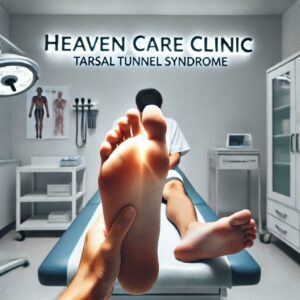Have you ever experienced unexplained discomfort in your feet, such as a burning sensation, tingling, or shooting pain? If so, you might be dealing with an underlying nerve condition, one of which is Tarsal Tunnel Syndrome. This often-overlooked condition can shed light on mysterious foot pain and its connection to your body’s intricate nerve network.
At Heaven Care Clinic, we aim to empower our clients with knowledge about foot health. Let’s explore what Tarsal Tunnel Syndrome is, how it occurs, and the steps you can take to find relief.
What Is Tarsal Tunnel Syndrome?
Tarsal Tunnel Syndrome is a nerve condition caused by compression of the posterior tibial nerve, which runs along the inside of your ankle. This nerve travels through a narrow space called the tarsal tunnel, located near the bony prominence of your ankle.
When this nerve becomes compressed or irritated, it can lead to pain, numbness, or tingling sensations in the foot and toes.

Symptoms of Tarsal Tunnel Syndrome
- Burning or tingling sensations in the foot, especially the sole.
- Numbness or a “pins and needles” feeling.
- Sharp, shooting pain that may radiate to the toes or heel.
- Worsening discomfort during prolonged standing, walking, or physical activity.
If you’re experiencing these symptoms, it’s essential to seek professional evaluation to determine if Tarsal Tunnel Syndrome is the cause.
What Causes Tarsal Tunnel Syndrome?
- Foot Structure: Flat feet or fallen arches can place added pressure on the posterior tibial nerve.
- Injury: Ankle sprains or fractures can lead to inflammation in the tarsal tunnel.
- Swelling: Conditions like arthritis, diabetes, or cysts near the tarsal tunnel can compress the nerve.
- Overuse: Repetitive movements from sports or activities can irritate the nerve.
The Nervous System and Foot Pain
The nerves in your feet form part of an intricate system connected to your spine and brain. Pain in one area of the foot can sometimes be linked to issues elsewhere in the body, such as nerve entrapment or inflammation along the pathway of the posterior tibial nerve. Recognising this interconnectedness is crucial for diagnosing and treating foot pain effectively.

How Is Tarsal Tunnel Syndrome Diagnosed?
Diagnosing Tarsal Tunnel Syndrome involves a thorough examination, including:
- Physical Assessment: Checking for tenderness, swelling, or areas of numbness.
- Nerve Tests: Measuring electrical signals in the posterior tibial nerve.
- Imaging: MRI or ultrasound to identify cysts, swelling, or structural issues.
Early diagnosis is key to preventing worsening symptoms and long-term nerve damage.
Treatment Options for Tarsal Tunnel Syndrome
At Heaven Care Clinic, we offer a range of treatments tailored to your specific needs:
1. Conservative Approaches
- Custom orthotics to support your arch and reduce nerve pressure.
- Supportive, cushioned footwear to alleviate symptoms.
- Anti-inflammatory medications to reduce swelling.
2. Physical and Manual Therapy
- Stretching and strengthening exercises to reduce strain.
- Massage therapy to relieve tension and inflammation.
3. Advanced Interventions
- Corticosteroid injections to reduce inflammation.
- Surgery to release the tarsal tunnel in severe cases.
Preventing Tarsal Tunnel Syndrome
- Wear proper footwear that supports your arches and avoids tight-fitting styles.
- Maintain a healthy weight to reduce strain on your feet and nerves.
- Warm up and stretch before physical activities.
When to Seek Help
If you’ve been experiencing persistent foot pain, tingling, or numbness, don’t ignore it. At Heaven Care Clinic, our team of experts is here to assess your symptoms, provide a diagnosis, and guide you toward effective treatment options.
Your foot health matters, and we’re here to help you every step of the way. Contact us today to book an appointment and take the first step toward a pain-free future!








 BY AFDV MARKETING.
BY AFDV MARKETING.